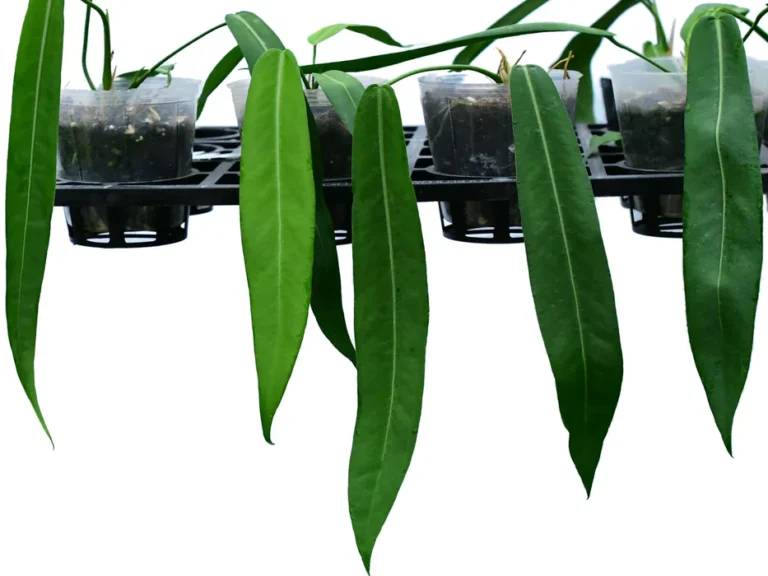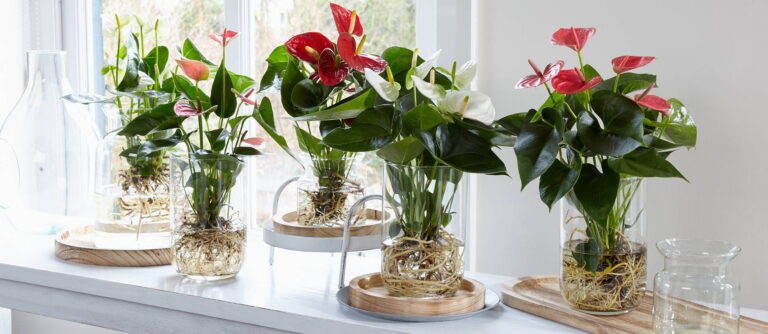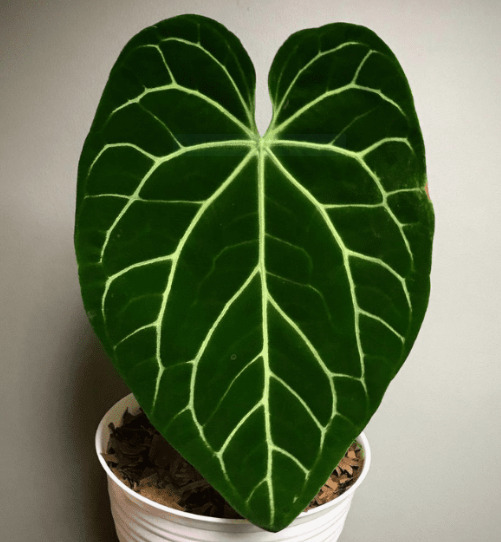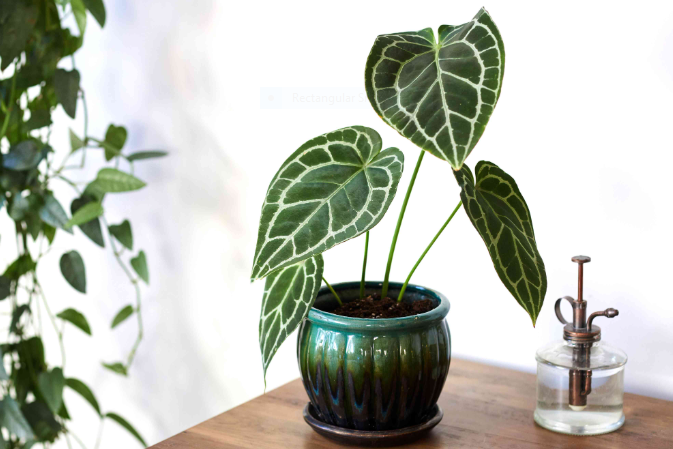Anthurium Warocqueanum: Forms, Hybrids, Care, and Propagation
Anthurium warocqueanum, also known as the Queen Anthurium, is a stunning tropical plant equally loved by beginners and advanced plant enthusiasts. Its velvety, dark green leaves exude an irresistible charm. This regal plant, despite its sensitivity, requires minimal attention.
In this blog post, we will briefly discuss Anthurium Warocqueanum, its different forms, hybrids, care requirements, and propagation techniques.
Let’s dive in!
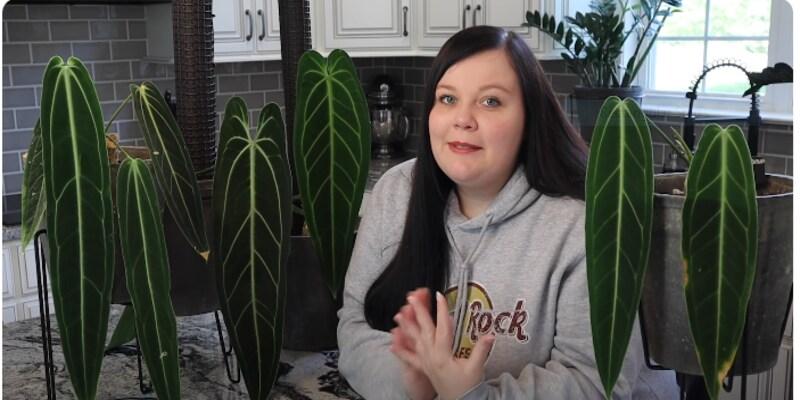
What is Anthurium Warocqueanum?
Anthurium Warocqueanum, aka queen anthurium, is an epiphytic tropical plant in the Araceae family that grows in wet lowlands and mountain valleys. The plant is native to the tropical rainforests of Colombia. This Queen Warocqueanum produces magnificent foliage that can reach impressive sizes. When the plant reaches maturity, its velvety leaves can reach 1 meter in length.
The Queen Anthurium produces dark green to lighter green leaves with more or less pronounced silvery white veins. A healthy Warocq can produce 6-8 leaves simultaneously.
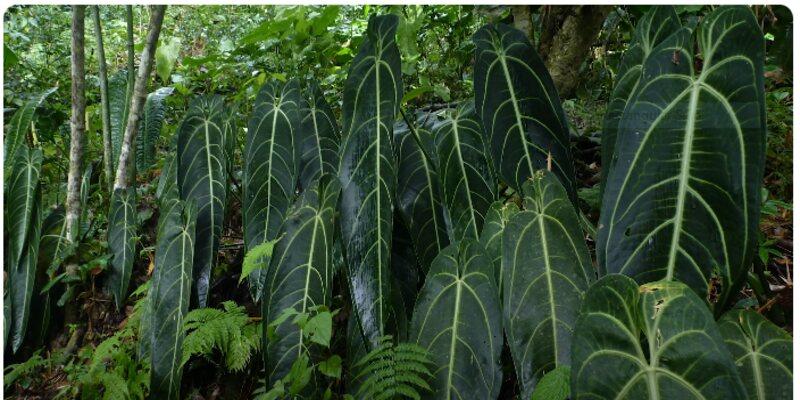
What Are the Differnet Forms of Anthurium Warocqueanum?
Anthurium warocqueanum Green Vs. Narrow Dark Form
When you search different forms of Anthurium Warocqueanum, you will find regular, green form, narrow form, or dark form, sometimes referred to as “Black Warocq.” Do these forms exist?
Actually, there is only one form of Anthurium Warocqueanum and these might look different from plant to plant due to natural variation. The Queen Anthurium is a highly variable species. Some Warocqs will have green leaves, some with narrow leaves, and some may have very dark black leaves with silver veins.
What Are the Different Hybrids of Anthurium Warocqueanum?
The Queen Anthurium has the following hybrids:
1. Anthurium Warocqueanum X Papillilaminum
Anthurium warocqueanum x papillilaminum, also known as “Dark Moma” or “Dark Mama,” produces dark green foliage. It gets the characteristic ‘ears’ from Anthurium papillilaminum and the dark velvety leaves due to warocq.
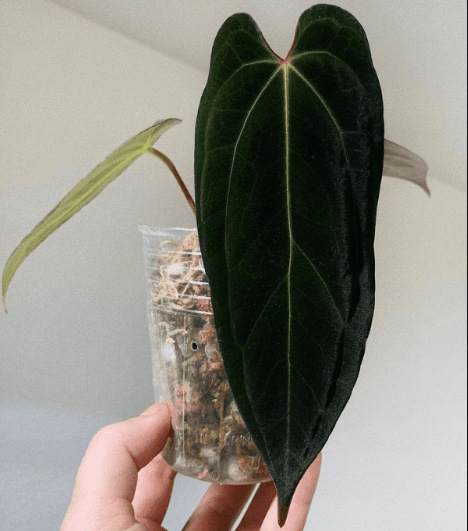
2. Anthurium Warocqueanum X Luxurians
Anthurium warocqueanum X luxurians produces fantastically textured leaves! Its parents Luxurians, produce a pebbled-like texture, while its elongated leaf shape resembles the queen.
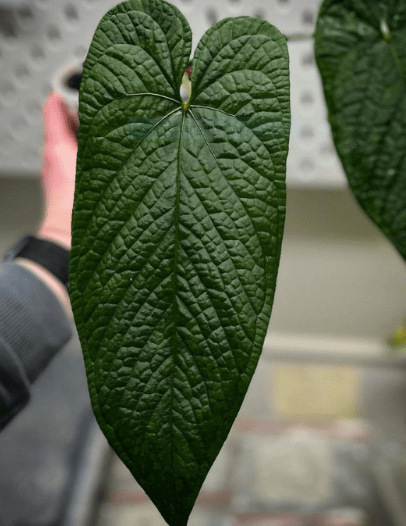
3. Anthurium Warocqueanum X Rugulosum
When Anthurium warocqueanum when crossed with Anthurium rugulosum, we get this beautiful hybrid. Its beautiful pebbled leaf texture is due to rugulosum, and its elongated shape is due to Warocq. The plant’s mature leaves become even more corrugated.
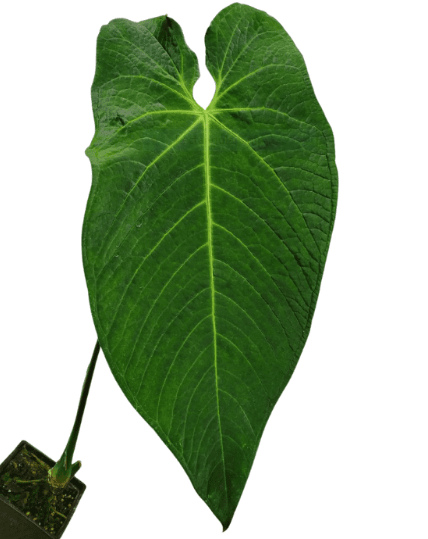
4. Anthurium Warocqueanum X Marmoratum
The dark green leaves of this gorgeous hybrid are due to Anthurium warocqueanum and a wider, slightly ribbed texture due to Anthurium marmoratum. This plant is grown in 60% humidity and 14 inches from the grow lights.
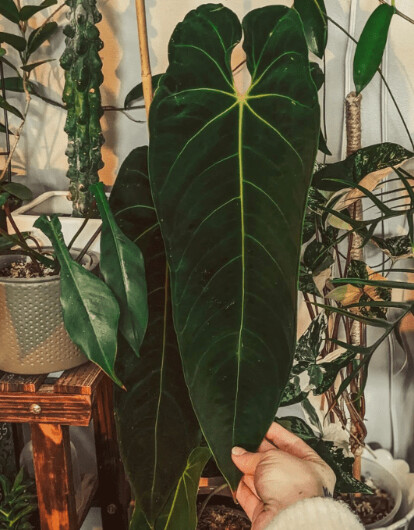
5. Anthurium Warocqueanum X Waterburyanum
This hybrid is a beauty, but, unfortunately, just as temperamental as the queen herself. Its leaves have a velvety texture and grow to a massive size.
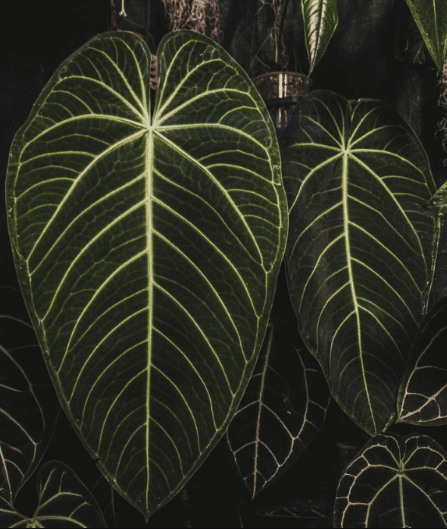
6. Anthurium Warocqueanum X Magnificum
This hybrid produces heart-shaped and elongated leaves that are leathery when touched.
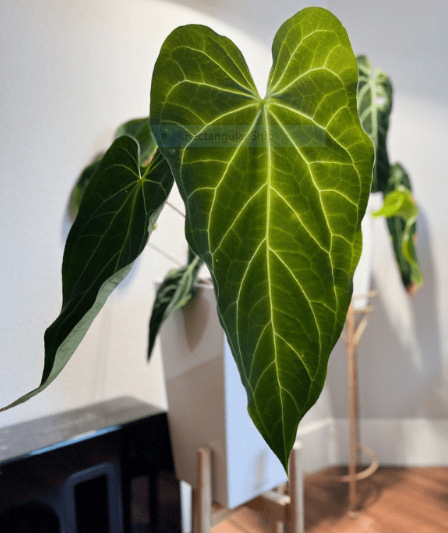
7. Anthurium Warocqueanum X Crystallinum
Another hybrid of Anthurium Warocqueanum that produces longer and thinner leaves. Its leaves are dark green and have visible silver veins. The hybrid belongs to the Phernodendron fernii. Its leaves are sensitive to airflow and humidity. The hybrid grows exponentially at 70-80% humidity.
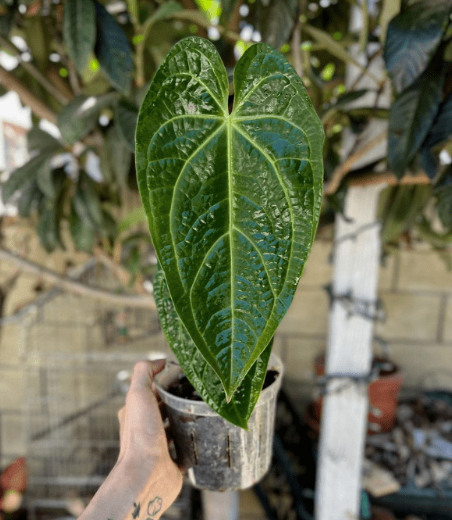
How to Care For Your Anthurium Warocqueanum?
Follow the tips below to care for your Queen Anthurium.
1. Anthurium Warocqueanum Humidity Requirement
Anthurium warocqueanum prefers high-humidity conditions to grow well.
The humidity level depends on the season and the location where you place your plant. If your plant grows in the greenhouse, the humidity of 80 to 90 percent will be good for its ideal growth. However, if you are growing your queen Anthurium indoors, it will be less than 50 percent.
Average humidity can also keep your Anthurium plant happy with proper watering and care. Frequent watering is the only solution to make your plant happy and lovely when grown indoors.
Is adding a humidifier good for queen anthurium growth?
A humidifier is not needed if the humidity level is 50 percent or more. However, if humidity drops below 50 percent, a humidifier should be added near your plant.
Ensure your plants’ leaves are dry because wet leaves can cause fungal and bacterial problems.
2. Potting Requirements For Your Anthurium Warocqueanum
Like Strap Leaf Anthuriums, this queen of plants can adapt to various growing conditions. Whether it’s an aroid mix, sphagnum moss, or lechuza pon, the key is providing a chunky, well-drained mix that allows ample air circulation around the roots.
Here are some popular growing media that you can use to grow your Queen Warocqueanum.
- Aroid mix
- Sphagnum moss
- leca
- Lechuza pon
1. Aroid mix
Like many other anthuriums, warocqueanum loves to thrive in an aroid mix. For better growth,
is necessary.
2. Sphagnum moss
Queen Anthurium roots grow earlier when they are growing under sphagnum moss.
If your Queen Anthurium grows in moss, it needs more watering and fertilizing for better growth. Sphagnum moss does not provide nutrients in this case.
Plant lovers add perlite to protect moss from compressing and boost air circulation.
3. Leca
Leca commonly means lightweight clay. This is the best option for house plant lovers looking for the best alternative to soil. For rooting and propagation of your plant, use perlite with leca. It keeps your plant’s roots healthy and aerated, preventing it from rotting.
4. Lechuza Pon
Lechuza pon is made of pure and pollutant-free mineral stones. Its popularity is mainly due to semi-hydro growth.
3. Lighting Requirements for Anthurium Warocqueanum
Anthurium warocqueanum is a sun-loving tropical plant that grows best in medium to bright sunlight. Excess and direct sunlight can be harmful and burn its leaves.
The best range of light for queen anthurium growth is 10,000- 20,000 lux. For outdoors, choose a partially shaded area for the queen anthurium—the intensity of sunlight changes throughout the year. In winter, growing lights are the best option for indoor plants.
Does the height of anthurium warocqueanum matter?
Yes, it matters. Heightened Queen Anthurium requires less light than shorter ones. Adjust lighting according to your plants’ stress signs, such as burning leaves or skinny growth.
4. Anthurium Warocqueanum Watering Requirements
The Queen Anthurium requires frequent watering. Avoid overwatering, as this makes its soil soggy. Queen anthurium loves to thrive in moist soil.
Watering is necessary when the upper layer of soil feels dry during summer. Ensure proper water drainage and repeat this process every 7-10 days.
During winter, the plant goes dormant and requires less water to flourish.
Before watering your Queen Anthurium:
Some Useful Tips:
- Smaller Pots: Use small pots as they require frequent watering because the soil dries faster.
- Bright light: Under bright sunlight, evaporation is faster, so your Queen Anthurium needs frequent watering to thrive.
- High humidity: When high moisture, the soil remains moist for an extended period, so you do not need excess watering.
5. Temperature Requirements For Your Queen Anthurium
The temperature requirement for your anthurium warocqueanum varies according to the seasons.
In summer, the best temperature range for queen anthurium is 75 degrees Fahrenheit to 85 degrees Fahrenheit. Temperatures above or below this range can hinder your plant’s growth.
Temperature fluctuations have adverse effects on plant growth. So always place your plant in a stable environment to keep it healthy and stress-free.
6. Fertilizer Requirements for Your Anthurium Warocqueanum
The Queen Anthurium, when grown indoor plants, needs extra fertilizers for proper growth. The main reason is a shortage of water and nutrients in the soil.
There are two options for organic fertilizing. I prefer fertilizers that have phosphorus, nitrogen, and potassium. Fertilize your Queen Anthurium once a week or when necessary to keep it happy and thriving.
In winter, during the dormant phase, apply liquid fertilizer every 4-6 weeks because of the more relaxed and shorter days. With proper care, she will happily flourish in the next growing season.
In summer, your queen feels hungry. Give her a diluted fertilizer almost every 2-3 weeks. This enhances the beauty of its green, glossy leaves for extended periods.
In the spring season, Queen Anthurium’s dormant phase ends. This time is best for caring for Anthurium warocqueanum. Give her a balanced fertilizer with a high nitrogen concentration every 3-4 weeks. This gives you a stunning look at Queen Anthurium.
In autumn, apply balanced fertilizers to your gorgeous queen every 3-4 weeks. This prepares your queen for the next winter season.
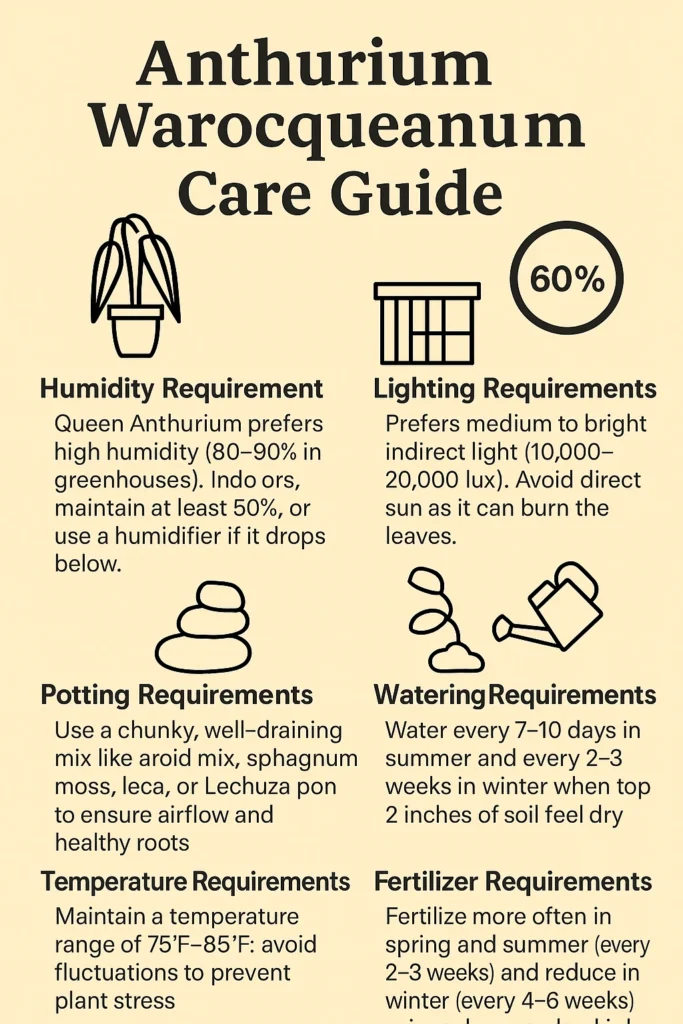
When to Repot Your Queen Warocqueanum Anthurium
Repot your Queen Anthurium almost every 2-3 years for optimal growth.
When and How to Prune Anthurium Warocqueanum?
Pruning is necessary if you want a healthy and stunning queen anthurium indoors and outdoors. Trim all the damaged or wilted leaves for optimal growth and better airflow.
When: Pruning is best when it stops flowering. Do it every year to make your queen happy.
How: Always use clean scissors to trim different damaged parts of your plant.
Tip: Pruning is the most excellent way to maintai
n your queen’s size and shape. This process boosts the growth of your plant and enhances its appearance.
How to Propagate Your Queen Anthurium?
You can propagate your queen plant with 3 to 5 leaves when it matures by stem cuttings and modern techniques. The growing season is the best time to propagate your Queen Anthurium.
The following are the different methods or techniques that you can use to propagate your Anthurium Warocqueanum.
Stem Cuttings
Here’s a guide that you can follow to propagate your plant through stem cutting:
Supplies: You will require a well-drained pot, a sterilized blade, the best potting mix with drainage holes, and sphagnum moss.
First, choose a stem with at least one node. With a sterilized blade, apply a cut below the node.
Second: Make a hole at the bottom of the pot and fill it with potting mix. Carefully insert the cutting of your plant so the node is buried. After this, water the plant well.
Third: Make sure the soil is moist. After this, place your plant in a humid and warm place.
This method will take multiple weeks for roots to grow well.
Advanced Techniques Used to Propagate the Queen Anthurium
Tissue culture
Tissue culture is the best method for quick growth of many plants. It requires a controlled environment in which plant cells are multiplied and isolated.
Why tissue culture method beneficial?
It has three reasons, which include;
Rapid Propagation Techniques
If you want new growing plants in a short time, then use these two popular methods which are:
Every technique has its requirements. You must choose the one that best suits your needs based on your available resources.
Pest Attacks and Common Diseases of Anthurium Warocqueanum
Diseases:
Pest Attack:
Mealybugs: This fluffy white insect causes mold growth and weakness through its sticky residue.
Common Problems with Anthurium Warocqueanum and Their Solutions
1. Yellow leaves
Solution: Overwatering is the leading cause of leaf yellowing. Before watering, check the soil of your plant. If it feels dry, then water it according to its needs.
2. Slow Growth and Development
Solution: Bright and indirect light is necessary for the faster growth of your queen anthurium. Prevent it from direct sunlight because this can hinder its development.
3. Brown Edges of the Leaf
Solution: Your plant is facing improper watering, which causes brown edges of leaves. Sometimes, the soil gets too dry, and sometimes, it gets too wet. So, proper watering is the solution to make your plant happy.
Also Check What is Anthurium Pallidiflorum?
FAQS
Is Queen Anthurium Toxic to Pets and Humans?
This tropical plant is a toxic species of anthurium. Its poisonous compounds are harmful to humans and animals.
Calcium oxalate is a harmful chemical for humans, pets, and children. Please do not take any bites of its flowers, leaves, etc.; it can also irritate your skin.
It’s better to keep your pets and children away from Queen Anthurium.
How to stake Queen Anthurium?
Take a taller piece of wood than your queen anthurium. Insert it into the soil of your plant. Carefully gather stems of your plant to stake, which gives support. By doing this, your plant starts to grow in an upright direction.
How cold can Queen Anthurium tolerate?
If the temperature drops below 20 degrees Celsius, your plant’s growth will be negatively affected. This plant is frost-sensitive, so be careful about any fluctuation in temperature.
Does anthurium warocqueanum have a fragrance?
This queen plant has no notable fragrance, so it is a safe option for those sensitive to strong scents.
Is Queen Anthurium expensive or not?
Yes, Queen Anthurium is slightly expensive because of its rarity and size. You can get a small queen plant for 50 dollars while mature, or for 1000 dollars.
Conclusion
Anthurium Warocqueanum, also called the Queen Anthurium, produces the stunning dark green to lighter green leaves that attract many plant enthusiasts. The plant has only one form but has multiple beautiful hybrids that you can also grow indoor.
Anthurium Warocqueanum is easy to care for. It requires frequent watering, bright light, high humidity, fertilizer during its growing seasons, and regular pruning of dead and damaged leaves for optimum growth.
If not properly cared for, it can produce yellow leaves with halted growth and can be susceptible to pest and disease attacks.

About Author
Hi, I’m Emily Davis, a passionate tropical plant enthusiast dedicated to sharing knowledge and expertise with plant lovers. Through his blog, I will provide guides, tips, and tricks for caring for tropical houseplants species like Alocasia, Anthurium, Calathea, Philodendron, Begonia, and many more that will help readers bring a touch of paradise into their own homes. With a deep love for the vibrant colors and lush textures of tropical flora, I’m committed to inspiring others to cultivate their own tropical oasis.


